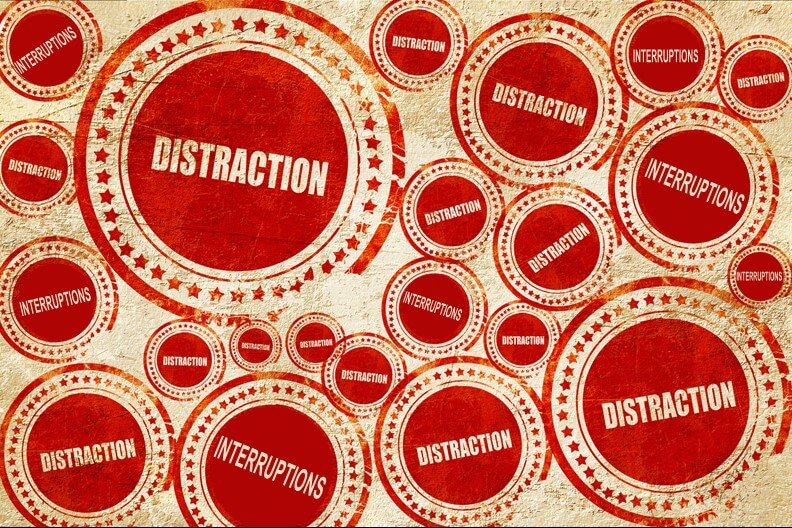Distractions and interruptions during corporate meetings are annoying. However, the potential impact goes well beyond being just an irritation. When a disruption from an attendee occurs, it can take the meeting off track and/or cause it to run over time. Worse yet, interruptions can decrease engagement among other attendees.
Interruptions are a real and present threat, especially to engagement and productivity:
- Only 50% of employees feel their ideas are heard during meetings. (1)
- More than 60% of employees multitask during virtual meetings. (1)
- Female employees are interrupted more often than male employees during meetings. (1)
- 39% of employees admitted to dozing off during a meeting, and 91% admitted to daydreaming. (1)
- It takes an average of 23 minutes and 15 seconds to get back on task after being interrupted. (1)
Interrupting the interrupter to stop the disruption is tricky. While you want to be firm, you should avoid coming off as harsh or dismissive. Fortunately, there are effective strategies leadership can leverage to politely halt corporate meeting interruptions in their tracks.
1. Briefly Make Eye Contact with Each Person
As far as nonverbal cues go, eye contact is arguably the most powerful when it comes to maintaining control over a meeting. If an attendee looks like they are about to speak up out of turn, and you allow your eyes to lock with theirs, chances are good they will take it as approval to interrupt.
However, if you briefly make eye contact with each person, and then quickly look away, you minimize the risk of this happening. You might wonder, why make eye contact at all? Well, doing so is essential for keeping attendees engaged and making them feel included.
2. Let Attendees Know How Many Points You Will Cover
Sometimes people interrupt because they genuinely think that you have finished making your points. Other times they may fear they will not get a chance to speak at all.
You can resolve these issues by being upfront about how many points you will cover. This not only makes it clear to attendees when you will wrap it up, but it also establishes a boundary for them to respect. Doing so is reassuring to those people who feel strongly about sharing their insight and it helps set parameters for your role as a leader in the meeting.
3. Speak with Authority and Project Confidence
There are two characteristics you should never display if you want to keep the narrative of a corporate meeting on track: vulnerability and uncertainty.
Vulnerability, or a lack of dominance, gives people the idea that they can easily railroad you. You might be an incredibly strong person, but if you appear vulnerable to intrusive behavior from others, it can translate to weakness in their eyes. And the weaker someone thinks you are during a meeting, the more likely they are to steal control away from you.
Uncertainty is similar in that it invites others to assume dominance over you. It also belies all the knowledge and expertise you possess. One of the quickest ways to let a meeting spiral is to portray a lack of authority.
How can you avoid depicting vulnerability and uncertainty? By speaking with authority and projecting confidence. While some would suggest “faking it until you make it” the better option is to choose to “be it until you become it.” This is one of the basic laws of attraction and empowerment. Whether you are a seasoned expert or still learning about a topic, it is the appearance of expertise that matters most in a meeting.
Make sure that you:
- Stand up straight with your shoulders square.
- Look attendees directly in the eye.
- Speak firmly and clearly.
- Wear a slight smile that shows you feel at ease.
4. Plan the Points You Want to Make and Stick to Them
Some people will get distracted or tune out what speakers in a corporate meeting are saying if they talk for too long. Say enough to make your point and convey important information. Resist the urge to drone on endlessly.
It is easy to get carried away, especially if you are passionate about the subject matter. You can reign yourself in by planning all the points you want to make. Think of it as your own mini-meeting agenda within the larger meeting agenda. This preparation will pay off when you realize how receptive meeting attendees become when you are concise.
5. Acknowledge That the Interrupter Is Heard
While you want to be firm in halting interruptions, you should still be respectful. This is best achieved by letting the interrupter know they are heard and that you appreciate what they have to say.
First, thank them for their input and make it clear that you value it. From there, tell the interrupter that you are going to finish making your point because it is important information for the group to learn. Finally, encourage the interrupter to share their thoughts once you have wrapped up yours.
6. Remain Cool, Calm and Collected
Maintaining your composure during meeting interruptions can be challenging, but it is essential for earning the respect and deference of domineering colleagues. Regardless of how many interruptions occur, and how pushy the interrupters get, stay strong.
Portray a cool, calm, and collected demeanor at all times ─ even if you are stumbling or boiling internally. Never let meeting attendees see you sweat.
Minimize Interruptions to Keep Attendees Engaged
You will not be able to circumvent all interruptions during a corporate meeting. However, by employing these strategies, you can minimize them significantly. The result will be attendees that are more engaged and meetings that are more productive.
Contact Gavel International to learn more about how outsourcing can help your organization plan engaging and productive in-person meetings.
_______________________
SOURCE(S):
1 https://www.goldenstepsaba.com/resources/time-wasted-in-meetings#
- 4 Tips for Preserving Company Culture and Morale While Scaling Up - June 23, 2025
- Revitalize Meetings with Engaging Breakout Sessions - June 9, 2025
- Reconsider Best Practices Before They Leave Your Business Stranded - May 26, 2025






